The digiZoid ZO

After a month of waiting for them to get more supply, I finally received my digiZoid ZO 2.3. The box calls it a "personal subwoofer" which sounds entirely ridiculous, but thinking about it I can't seem to come up with any better tagline myself.
The ZO is a $100 headphone amp, which digiZoid says is capable of driving cans up to a fairly demanding 300Ω. Its main claim to fame, however, is a unique bass-boosting technology they call SmartVektor. Not your dad's one-note bass-boosting EQ, SmartVektor adds an addictive warmth and preserves texture while bringing even the slightest hint of bass into the foreground.
The device
Operating the ZO is pretty simple, having a large LED bar on the front, a multi-function rocker on one side, and a Mini USB port on the other side for charging. The case has a nice soft rubberized feel, though it looks a bit cheaply built.
With 32 contour levels, the ZO allows you to fine-tune the bass boost for your cans, music, and tastes. Controlled by the rocker, the front LED fades from green to red as the level increases. The lowest contour is nearly transparent, just barely warming and rolling off around 30Hz. A few levels up at a yellow-green color and the boost becomes undeniable and without any rolloff. At red the boost has such an intensity that even the biggest bass-heads might find it too strong.
While digiZoid did put some effort into making the contour levels perceptually linear in the ZO 2, it's still not quite there. The majority of the boosting still happens in the first half of levels, with the difference between orange and red being very small.
Also present are low- and high-gain modes, configurable by pressing the side button once the ZO is turned on. Some have mentioned they can hear a difference (other than volume) between low- and high- gain modes, but I haven't been able to detect any.
Intended for usage with line-out, the low-gain mode allows you to attenuate the volume with a 32-level digital volume control. Again, the volume control doesn't seem to be perceptually linear either—at about 8 steps in it's already quite high, and will slowly get about 2x louder in the remaining 24 steps. The LED indicator also reflects this, not applying the ~2.2 gamma required to linearize it for human vision.
Once the volume is as high as it can go, the LED will turn purple. Holding down the rocker for several more seconds will turn the LED pink, activating high-gain mode. Intended for use with headphone-out, high-gain mode lacks any volume control but will give a very significant boost to volume.
The ZO's maximum input is 250 mVrms in high-gain mode and 1 Vrms in low-gain mode, meaning it is fairly easy to overload it with a standard 2 Vrms line-out such as the one on my sound card. digiZoid recommends starting with your source volume at 25% and increasing the ZO and then the source's volume until it's at acceptable levels.
The box contains two 3.5mm male to male cables, one six inch and one three foot. They are perhaps the cheapest looking cables I've ever seen, but I suspect anyone who cares will already have some badass $200 cryo-treated cable of their own. To me, the six inch one is great for portable use.
One of the first issues I noticed while using the ZO is that one of the channels will sometimes (very rarely) cut out until you fiddle around with the cable. This appears to be an issue with the device itself, from the jack being slightly recessed and thus having a poor contact area with some cables. The cables included with the ZO have a small ring that fits the recessed area perfectly, and thus far have not exhibited the problem.
This is the fourth revision of the ZO. After being ignored for some time, the first began getting a lot of notice by audio forums like Head-Fi, which digiZoid was quick to join. After taking a lot of input from the community the ZO 2 was unleashed with a bypass mode, removed loud pops when you turned it on, and perceptually linear contour levels to allow much more fine-grained tuning at lower levels. The ZO 2.2 corrected hissing problems with IEMs and volume problems with line-out. The most recent revision, the 2.3, removed bypass functionality and added separate low- and high-gain modes to further correct problems with line-out.
Incredibly upon discovering issues with the previous revisions, digiZoid offered to replace virtually every ZO 2 with a 2.2, and then again every 2.2 with a 2.3. I've never seen this kind of above-and-beyond devotion to product quality and customer satisfaction before, especially with a device they're charging $100 for. This was actually one of the bigger factors that convinced me to take the plunge and get a ZO.
For how big of a punch it packs, the ZO is surprisingly tiny and portable. Here it is compared to—from left to right—the PenguinAmp Royal, Cowon D2, and in case you've never seen either of those, a credit card.
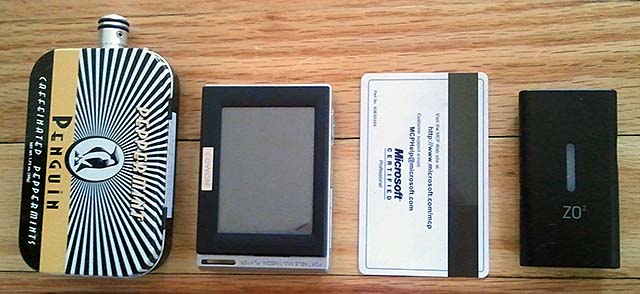
As far as testing goes, I've got several sides of the spectrum covered: the Beyerdynamic DT-770 Pro 80Ω, Superlux HD-668b, AKG K81 DJ, Etymōtic ER-6i IEMs, and Logitech Z-5300 speakers. For my sources I'm using a Cowon D2 (with D2+ firmware) for high gain mode and the line-out on an Asus Xonar D2 for low gain mode. I've been able to give it a good run listening to a variety of film scores, techno, and rock.
SmartVektor
Similar to BBE's Mach 3 Bass, SmartVektor is more than a simple low-freq EQ. Designed to process a purely analog signal, SmartVektor will easily integrate with pretty much any dumb audio system. For now it exists solely in the ZO, but digiZoid hopes to bring the technology into other less niche systems much like BBE has done.
Described in US patent application 20090290728, "DYNAMIC CONTOURED-SOUND/SUBWOOFER-SYNTHESIS AUDIO SYSTEM", SmartVektor attempts to compensate for both the human auditory system and the frequency response typical in speakers. Though the ZO currently only boosts bass, SmartVektor is also capable of operating on treble.
The sound of SmartVektor is a little difficult to describe. It seems to pull out detail that normally remains hidden deep in the bass, bringing it into the foreground for a rich, warm, textured experience that you'd normally only get with powerful speakers cranked to 11 and a dedicated subwoofer.
On initial use it was easy to set the contour level to yellow-orange and forget the ZO was even connected. After realizing this, I'd constantly turn it down to green to see if it was actually doing anything. Like night and day, turned down the music just deflates and becomes lifeless.
More often than not it simply makes music sound better and most importantly, natural. Using it doesn't feel dirty or disrespectful to all the hard work artists put into the creation of the music.
RMAA
This is the first time I've used RMAA, but I believe I did everything right. (Well, as right as it can be.)
All testing was done from my Xonar D2's line-out into the line-in with a 75Ω load at 24-bit and 48kHz. Unfortunately RMAA continued to either crash or not pick up any signal every single time I plugged in my Cowon D2 to test BBE's Mach 3 Bass. If anyone knows what would cause that, please let me know!

Here you can see the ZO's initial contour levels. A green level (contour 1 on the graph) is very nearly transparent, with a rolloff beginning at around 90Hz and passing below 0dB at around 40Hz. At yellow-green (contour 4) the boost is a very audible 4dB with a rolloff beginning at around 50Hz. With rolloffs still well within the audible range, it's possible that some will be able to notice it depending on how low their setup can reproduce.
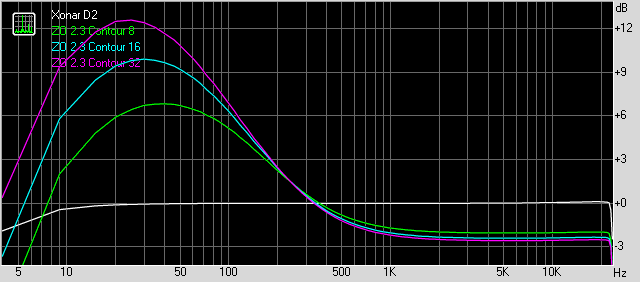
At a yellow contour (8 on the graph) the boost reaches around 6dB with a rolloff beginning around 40Hz. At this point the rolloff should be nearly inaudible. Perhaps coincidentally, this is the level I preferred most of my music at. At orange (contour 16), it hits around a 9dB boost. At it's highest contour (red), the boost reaches just around 13dB.
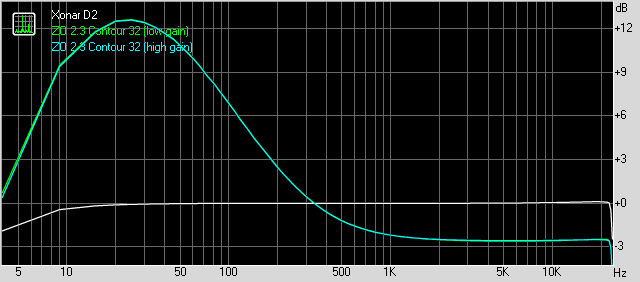
Some have mentioned hearing a difference between low- and high-gain modes. My tests here show them to be identical, so I'd be curious to know what setups people are using that let them hear a difference.
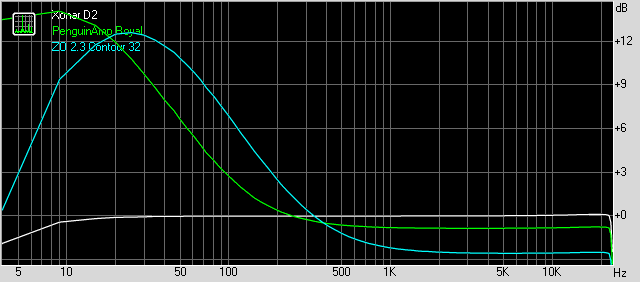
And finally we have a comparison between the PenguinAmp Royal's highest bass boost and the ZO's highest contour. The PenguinAmp peaks at 14dB—just a smidge above the ZO—and has no audible rolloff.
Despite boosting by similar levels on paper, the ZO actually sounds much louder due to its peak being about 15Hz higher. This creates a ~3dB gap at frequencies which are both easier to hear and easier to reproduce. The ZO sounds far more detailed as well, which contributes significantly more than simple intensity.
Beyerdynamic DT-770 Pro 80Ω
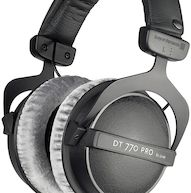
The Beyerdynamic DT-770 Pro 80Ω are bass-heavy cans. Properly paired with an amp the bass becomes very tight and textured, with a preference toward deep bass keeping them punchy without muddying up anything.
The ZO has no problem driving these 80Ω/96dBSPL cans, with no noise to speak of. Kept between green and yellow, this combination provides mind-numbing bass that I'm comfortable listening to for hours. Bring it up towards orange and bass will become far too heavy, and with some songs even causes distortion as the drivers begin to run out of excursion.
I wasn't sure how the ZO would sound with already bass-heavy headphones, but it turned out to be pretty damn good. Kept to low contours, the ZO adds a lot of texture and warmth without diminishing other qualities.
Superlux HD-668b

Monitors in every sense of the word, the Superlux HD-668b are very analytical, with impressively crystal-clear mids and highs and a very muted bass response.
These have the least amount of bass I've heard from any full-sized headphones, so to me they were the real test for the ZO's magic. Thus far, I've not heard a single bass boost which could make these cans thump. Again the ZO had no problem driving these 56Ω/98dBSPL cans, with no audible noise. Everything from yellow all the way up to red works wonderfully without any distortion.
While not nearly as intense as the DT-770s, the ZO does give these a respectable amount of tight, detailed bass. These really are excellent sounding headphones for the price, and adding the ZO rounds them out very nicely.
AKG K81 DJ

The AKG K81 DJ are bass-heavy and a tiny bit warm, with slightly rolled off highs.
The ZO drove these sensitive 32Ω/100dBSPL cans well, again without any audible noise. A green-yellow contour level is the sweet spot, with bass becoming far too strong around orange. For those wanting to clean some wax out of their ears, the ZO works all the way to red without any distortion, even at high volumes.
The K81 DJs aleady have a lot of bass to offer, but the ZO helps tighten it up and adds a lot of detail. If you can handle the headband's squeeze of death, the ZO and the K81 DJ will make a very good pair when portability is required.
Etymōtic ER-6i

The Etymōtic ER-6i are cold and analytical, with fantastic mids and highs. Typical of affordable balanced armature IEMs and probably moreso than most, there is no bass to speak of.
At 16Ω/110dBSPL, these are very sensitive and will usually pick up any flaws in what they're plugged in to. Unfortunately, there is a lot to pick up with the ZO. There's an audible hiss—independent of volume, gain mode, and contour level—which is very noticable in quiet parts. In comparison, it has around 3x the hiss of my Asus Xonar D2, and 2x the hiss of my Cowon D2. Another noise, less of an issue, is an only slightly audible click every time the volume is adjusted in low-gain mode.
Using a resistor adapter does alter the sound slightly, but is well worth it as it will quiet all the hiss. A 32Ω adapter would probably be plenty, but I've only got a 75Ω one and the ZO has plenty of power to spare.
Even moving all the way up to red, the ZO provides next to no bass—I suspect these IEMs just aren't physically capable of it. Don't let that discourage you though, because it does significantly improve the experience by adding a huge amount of warmth. If your music doesn't have a lot of dynamic range or if you have a resistor adapter, I can definitely recommend the ZO for thawing out these impossibly cold IEMs.
Logitech Z-5300
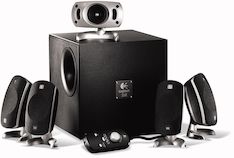
The Logitech Z-5300 are definitely not audiophile-grade speakers. Designed for mid-range 5.1 gaming, they're warm, very heavy on the bass, and not super accurate.
I've had them for nearly 10 years and they've done the job well enough both for the paint-chipping thud of an AWP going off in Counter-Strike and following my evolution through the overly-loud musings of a teenager's popular rap and rock, a software programmer's thumping techno, and finally into more refined film scores and indie rock.
Given SmartVektor's claim of correcting for the frequency response in speakers, I wasn't sure what to expect when paired with a 6.5" 100W (RMS) sub. Unlike headphones, I didn't notice much more texture in the bass—it appears the sub was already doing that plenty well on its own. It did, however, become much deeper and certainly more powerful. The satellites did become warmer and bassier, but only slightly.
The sweet spot to me was a contour level of yellow, though the ZO was able to function fine from green all the way to an intollerable red with no audible distortion or noise. The system already had plenty of bass for me so I don't think I'll be pairing the ZO with it in the future.
Music
Overall the ZO seems to work great with pretty much any popular music. The device does unfortunately shrink the soundstage, so music with a lot of bassy instruments may become a bit muddy if used at a high contour level.
Film scores
Synthesized '80s scores tend to sound really fun. Jerry Goldsmith's Gremlins and Bear McCreary's '80s-inspired Zom-B-Movie are awesome. Simple action music and ethnic instruments also fair well—Greg Edmonson's Uncharted 3 and Harry Gregson-Williams' Prince of Persia: The Sands of Time both sound incredible.
Complex orchestral arrangements with a lot of intruments are the ZO's downfall, easily becoming muddy and losing subtle instruments while over-emphasizing others. This seems to be very dependent on the cans, as my HD-668bs sounded far better than my DT770s here.
Rock
The ZO shines with rock. Korn's dubstep-infused The Path of Totality, Shiny Toy Guns' Season of Poison, Nine Inch Nails' The Slip, and The Whigs' Mission Control all sounded wicked.
On the flip side, I noticed some bass guitars tend to become over-emphasized. Unlike drums which stay punchy, the bass guitar quickly results in muddy, overbearing bass that risks swallowing vocals and other guitars. Again, this is very dependent on the headphones.
Techno
Techno works great, flat out. This is what the ZO was made for. Listening to Hadouken!'s For the Masses, Bassnectar's Divergent Spectrum, and all the DJs on afterhours.fm, the ZO is the next best thing to being there live.
'nuff said.
The bottom line
The ZO is an amazing, addictive device. The bass boost is hands down the best I've heard from any software or hardware-based solution, better than BBE's Mach 3 Bass and easily beating out the PenguinAmp Royal. As far as an amp goes, I'd say the quality is less than the PenguinAmp Royal but still far better than running with no amp at all.
Pros
- Affordable.
- Works pure magic on both the intensity and detail of bass.
- Easy to fine-tune for your setup and tastes.
- Highly dedicated and intelligent customer support.
Cons
- Low input tolerance.
- Recessed jacks cause poor contacts with many cables.
- Unacceptable hiss with sensitive IEMs.
- Contour and volume levels are still not perceptually linear.
- Slightly decreases soundstage.
Wishlist
- SmartVektor treble support.
- The ability to turn the bright LED off.
- A crossfeed switch.
Was it worth the $100? Absolutely. Very highly recommended!
